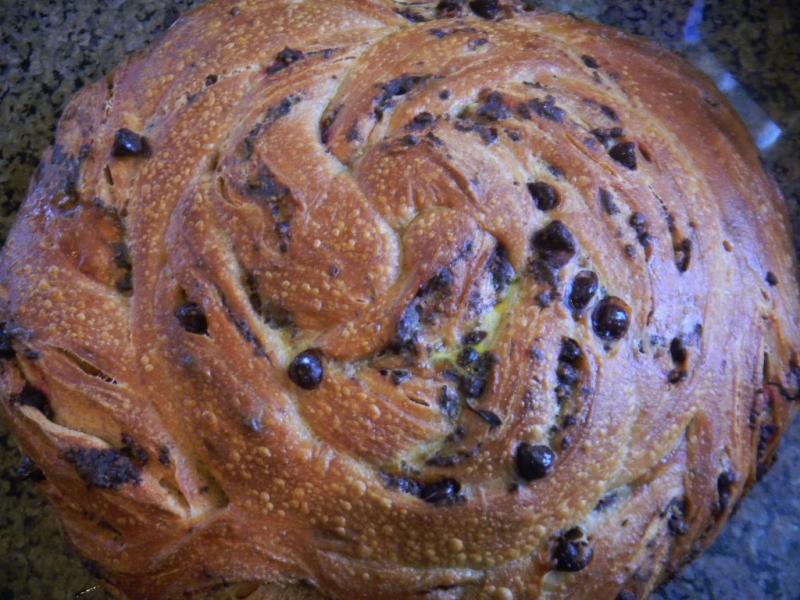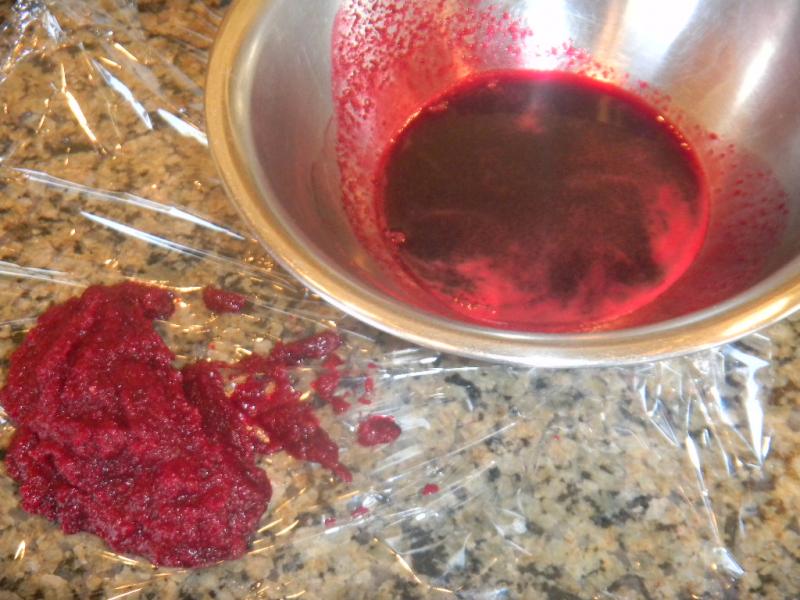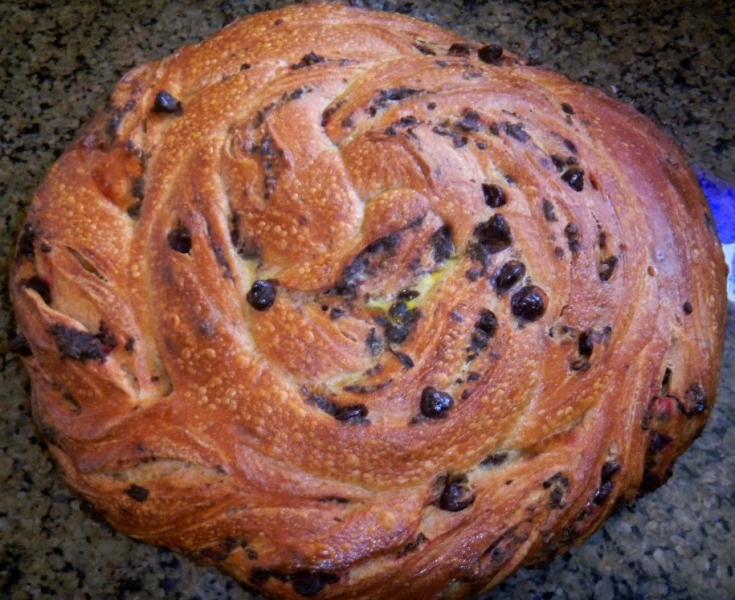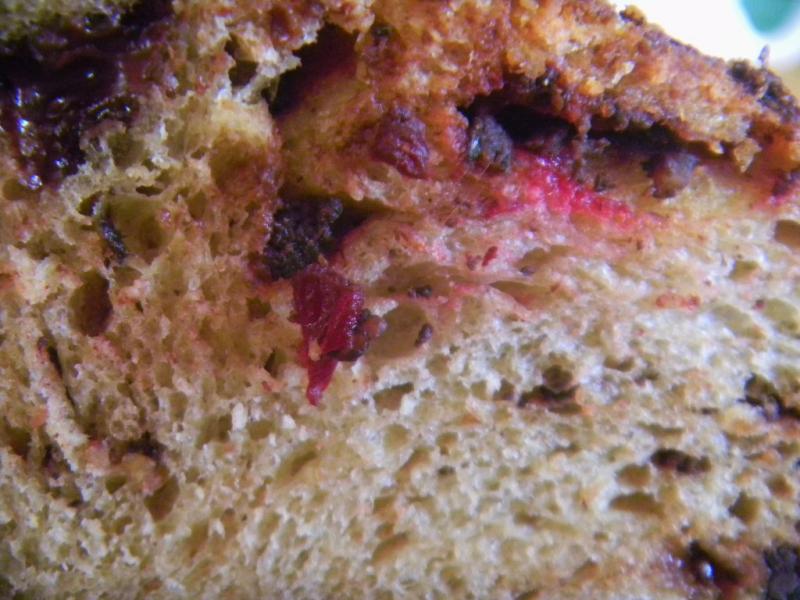I joined in on The 3 Twisted Sister’s GMA bake this week to do a Valentine Rose. The premise was to do Vienna bread dough and make it into a Valentine Rose somehow. The GMA’s posted their fine examples yesterday so this was a tough act, all 3 of them, to follow. But, we had the last of our left over panettone to use up and on our side.

There were all kinds of new things for us on this bake. We have never made a Vienna bread before and was sort of taken back by the sugar, egg, fat and milk in most of the recipes on the Internet. It was sort of Challah like when it came right down to it. There are some recipes out there without all of these enrichments but if you can use them all – why not?


We wanted to put our own twisted outlook into this bread so we decided to take it pink and savory only to change our mind later, after the savory was in, to take it sweet too. The pink came from slicing ¼ of a beet and putting it into the mini chopper with 50 g of water and having the mini chopper do its best to liquefy it. After straining, we were left with some really beet red juice and some red beet pulp.


We mixed the beet juice with the water for the dough and it ended up making a pretty as pink dough. The beet pulp we sautéed with some beet greens and a clove of garlic to use for the filling in the rose roll-up thinking savory was the way to go and the red and green filling would be nice in this bread.


Then at the last minute Red Velvet Cake into my apprentices brain somehow and she thought that the dough was more sweet than savory and some cocoa powder and sugar added to the filling would make it taste more red velvety. She also thought that some chocolate chips would also be a good addition to the filling since she and most ladies know roses and chocolates are the bare minimum for Valentines day.


I went ahead with Lucy’s recommendations wondering how the savory beet greens, beet pulp and garlic would jive with the chocolate and sugar. We added a mix of whole grains, to the leavain only. It was our usual rye, spelt, Kamut and whole wheat and got the whole grains up to nearly 20%.


While the last feeding of the levain was ongoing, we autolysed the rest of the ingredients sans filling for 3 hours. Once the autolyse and the levain came together we did 10 minutes of French slap and folds and then let the dough rest for 20 minutes before performing 3 sets of French folds on 20 minute intervals.


After the last fold we allowed the dough to rest 10 minutes before dividing it in two and rolling each out to 10” x 18” rectangle. We brush each with melted butter first then sprinkled on the beet green and pulp, sugar and cocoa mix followed by the chocolate chips.


We then rolled it up from the wide end, pinching the seams and ending up with a rope 18” long. After finishing the 2nd rope, we split each with a paring knife down the middle ending up with 4 rope halves.


Two of the rope halves were crossed in the middle and then braided each direction making sure to keep the cut side up. Once the other 2 half ropes were braided together, each of the 2 braided ropes were placed on a baking sheet covered in parchment by coiling each in a snail shape, one following the other, again trying to keep the cut sides up. The result was one fairly big pink rose.


We let it proof on the counter for 90 minutes in a plastic trash can liner before refrigerating it for a 12 hour retard. The next morning the rose was allowed to warm up and final proof for 4 hours before being brushed with an egg wash and going into the 425 F baking stone for 10 minutes of steam. We used a combo Sylvia’s steaming pans and David’s 12” Iron skillet with lava rocks for the steam.

The rose had expanded nicely while doing its final proof but it also sprang very well in the oven too. After 12 minutes the steam was removed and oven turned down to 350 F, convection this time. The bread was turned on the stone every 8 minutes to ensure even baking. The rose reached 205 F and we turned off the oven with the door ajar to allow the crust to further crisp on the stone for 8 more minutes.

The rose was removed from the oven to the cooling rack. Total baking time was 30 minutes – 12 minutes of steam and 18 minutes without plus 8 minutes resting on the stone for 38 minutes total. The rose browned nicely due to the egg wash. It is nice looking rose where we hope the pink survived under the crust but, we will not know for a couple of hours.

This bread turned out to be shocking 3 ways. One, the pink dough went away with just some red where the beet pulp and leaf saute was incorporated - I was robbed! Two, you can't taste any beet either - not a trace - nor the garlic either. Three, this bread tastes wonderful as a sweet chocolate bread. So if you want the pink to stay, put in some red food coloring :-)

The crumb is so soft, moderately glossy and fairly open. Where the yellow tinge in the crumb came from is strange since it is coming from a definite pink. I guess the egg and butter finally won out ? I love the taste of this bread but I also want tomake a straighten up Vienna bread without the goodies added in. It also has to be a fantastic bread on the sweet side.

Formula
Starter Build | Build 1 | Build 2 | Build 3 | Total | % |
WWW & AP SD Starter | 13 | 0 | 0 | 13 | 1.82% |
Kamut | 6 | 6 | 12 | 24 | 3.37% |
Spelt | 6 | 6 | 12 | 24 | 3.37% |
Dark Rye | 6 | 6 | 12 | 24 | 3.37% |
Whole Wheat | 6 | 6 | 12 | 24 | 3.37% |
Water | 24 | 24 | 48 | 96 | 13.47% |
Total | 61 | 48 | 96 | 205 | 28.77% |
| | | | | |
SD Starter Totoals | | % | | | |
Flour | 102.5 | 14.39% | | | |
Water | 102.5 | 14.39% | | | |
Starter Hydration | 100.00% | | | | |
Levain % of Total | 15.89% | | | | |
| | | | | |
Dough Flour | | % | | | |
Red Malt | 10 | 1.40% | | | |
Bread Flour | 300 | 42.11% | | | |
AP | 300 | 42.11% | | | |
Total Dough Flour | 610 | 85.61% | | | |
| | | | | |
Salt | 10 | 1.40% | | | |
Beet Infused Water | 320 | 44.91% | | | |
Dough Hydration w/o starter | 52.46% | | | | |
| | | | | |
| | | | | |
Add - Ins | | % | | | |
Sugar | 40 | 5.61% | | | |
Egg | 50 | 7.02% | | | |
NF Dry Milk powder | 15 | 2.11% | | | |
Butter | 40 | 5.61% | | | |
Total | 145 | 20.35% | | | |
| | | | | |
Total Flour w/ Starter | 712.5 | | | | |
Beet Infused Water 320 & Water | 422.5 | | | | |
| | | | | |
Hydration w/ Starter & Adds | 65.68% | | | | |
Total Weight | 1,510 | | | | |
% Whole Grain | 19.30% | | | | |
| | | | | |
Chocolate Chips | 100 | | | | |
Beet, Almond & Cocoa Filling | 120 | | | | |
| | | | | |
Filling is sauted beet leaves, 2 tsp ea cocoa & sugar | | |
35 g of almond meal & left over beet juice pulp | | | |